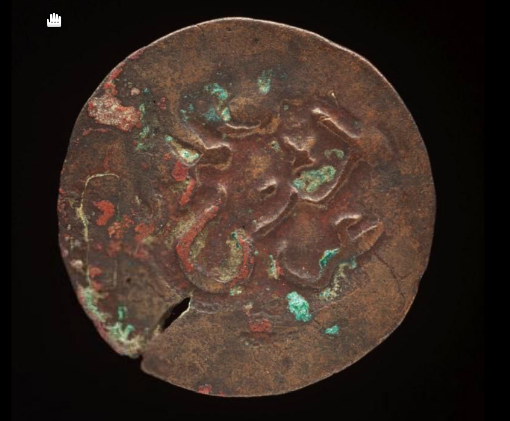The Wessel Coins #2: The Coins July 23, 2013
Author: Beach Combing | in : Contemporary, Medieval , trackbackIn a previous post we examined the background to the discovery of the Wessel Coins. Today, instead, it is time to look at why the coins are so exciting. It will be remembered that Morrie Isenberg came across nine coins on the beach in Jensen Bay. These coins break down into two classes, and this has been ignored in most of the reports because one of the classes is not that earth-shattering. Four of the coins were Dutch doits (aka dwits), minted in the Netherlands but actually for use in the Dutch East Indian Company. These coins were dated 1690-1784. Five of the coins were, instead, from Kilwa (another post another day), a small Arab state off the coast of what is today Tanzania. These coins – see an example above – have caused more controversy in terms of dating, not least because the sultans on the coins are difficult to pin down. Three sultans are named on the coins: Sulaiman ibn al-Hasan, Ali ibn al-Hasan and al-Hasan ibn Sulaiman. The problem here is that the names in the Kilwan royal dynasty repeated themselves and so it is difficult to know which of several sultans is referred to here. Dating has been kept vague then: 900-1300. What’s four hundred years between friends?
The Dutch coins are exciting, but not tear-up-your text books stuff. After all, those text books are quite clear. In 1606 the first reliably recorded Dutch landfall took place in Australia. These coins could be explained as belonging to one of a few dozen Dutch cutters that broke into Australian waters before the English made Australia their own in the eighteenth century. The Kilwan coins are, however, more troubling: the equivalent of putting your text book in a very large blender and sitting on the red button. Let’s say, just to make that blender as credible as possible, that the coins are thirteenth century. How do thirteenth-century coins from mid-southern Africa get to a northern Australian island? There’s no way of parsing this. It is embarrassing.
The Dutch coins are not as exciting as the Arab coins. But they cannot be ignored. Perhaps the strangest thing about the discovery of these coins is that the two ‘hoards’ (if that is what they were) came up on the same beach. If any explanation for Morry’s find could encompass both sets of coins, instead of offering two sets of explanations, one for each family of coins, then it would immediately head to the front of the pack. Let’s say, for example, that Mad Halliday, the English eccentric who planted coins in strange places to confuse later generations, had a documented holiday in the Wessel Isles. At that point it would be far easier to believe that Halliday had been in action, than that two separate groups of early explorers had landed on the same beach and lost some coins within a hundred yards of each other, several centuries apart. Of course, we have no reason for believing that Halliday (or anyone who shared his hobby) ever made it this far east, but there is a coincidence here and coincidences should make bizarrists anxious.
However, what is the possibility of some kind of fake: e.g. a Halliday wannabe, a joke played on MI? The first question to ask is how valuable the coins are? The Dutch coins could be picked up for fewer than twenty dollars apiece, perhaps fewer than five… As to the Kilwan copper coins these are rarer. But thousands have been found on Kilwa and on the nearby African coast. You could probably pick one up for around the same price as the Dutch coins, though you would find them less often in shop or on ebay. The point is that if anyone wanted to play a practical joke they would not have to sell the wife and kids to do so.
Then what about the coins distribution in the Pacific? Dutch East Indian coins are littered all over the east: as noted above this find is interesting but not amazing. However, Kilwan coins get, logically enough, fewer and fewer the farther you travel from Kilwa. And only one has ever been found outside of Africa, in Oman. Arab traders often mixed Muslim coins from different sultanates and there need be no surprise that a Kilwan coin arrived in Oman. However, it would have been less surprising if an Arabian coin arrived on the Wessels than a Kilwan coin. Kilwa is about as far as you can get from the Wessels (in terms of credible sea routes) within the Islamic world. But then perhaps who ever brought the coins did not come by a credible sea route. Memories of the colonization of Madagascar.
Next time Kilwa, but first any explanations for both sets of coins: drbeachcombing AT yahoo DOT com
28 July 2013: The Count writes in: Now, I had a theory about this, but I won’t bother to say what it was, because while doing a little internet research to confirm it, I discovered a much more plausible explanation. I found a useful article about the little-known fact that late 18th century Australia had such a chronic shortage of currency that just about any coin from anywhere might have been considered legal tender, and valued according to the weight of the metal. My guess is that both types of coin in the rather pitiful Wessel “hoard” were worthless curios picked up by a sailor which suddenly became real money again in the closing years of the 18th century. For an idea of how insanely diverse Australian currency was at this time, have a look here: Polmorphous-Perversely Numismatic Otto. Thanks Count!



